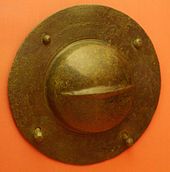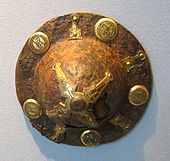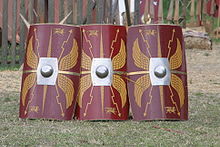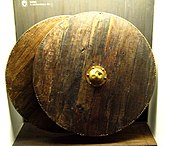Shield (protective weapon)
The shield (plural: shields ) is a protective weapon carried by a fighter . It is an often slightly curved plate made of wickerwork , wood , leather or other material. It serves to defend against melee weapons and projectiles from an attacker .
Word origin
“Schild”, as a masculine term for the article der , is derived from the Old Germanic scilt , also Old High German scilt “Abgespaltenes” (cf. Schindel ). In the 12th century the word went over to the shield colors on the coat of arms . Only in Middle High German is a neuter the shield ( plural shields ), " sign ". In colloquial language , the neuter article, such as "the heat shield", "the protective shield", is often incorrectly used in the word environment of the shield . As a rule of thumb for the correct use of gender , one can remember that only the sign that conveys information in the strict sense of the word is neuter. In related terms, especially with the coat of arms that convey information , it is called the shield.
The word found its way into the Germanic name treasure trove and became the namesake of the Danish Viking kings of the Scylfings dynasty , which are also known as Skioldinger . They are derived from Scylt and ruled Denmark between 700 and 950. Presumably, the Vikings wanted to use this name to represent the Danish dynasty as a protector. However, the kings of this dynasty cannot be proven, they are therefore considered to be legendary kings, as they are mentioned in Beowulf and other Viking sagas. In addition, there are various place names such Schildau, Schilda but are so notorious for their pranks, the Gotham . Unfortunately, it is not known who they actually were or whether they actually existed, but they have provided amusement for centuries. First names in this meaning are on the very rare -rand "shield" ( Wolfrand ).
history
Shields are among the oldest objects of protection in war history . Even the armies of the Pharaohs and Sumerians were armed with shields in which leather was drawn over a wooden frame. The first shields were fabric-covered wickerwork. Later the fabric was replaced by rawhide or leather and the wickerwork by wood. In the further development, the wooden shields were given metal reinforcements by means of an edge and boss . After all, they were made entirely of metal ( bronze shield from Lough Gur , bronze shield from Herzsprung ). Shields also served as ceremonial items.
Shields are guided either by a central handle that lies behind the shield boss (usually with round shields) or by leather loops for the forearm and hand (other shield shapes such as triangular shield). In addition, a long leather strap, the shield cuff, helps to direct the shield with just the forearm even without the hand strap (the hand then remains free to hold the reins). Shields also existed in two different designs: With one, the shield was carried with the shield shackle, as described above, with the other, e.g. B. in the Roman scutae , the shield was guided by a horizontal rod behind the hump.
The development of shields and weapons influenced each other: the more efficient the weapons, the more stable the shields became. Different fighting styles also led to changes in the shape of the shields. Warriors fighting on horseback, for example, carried smaller shields than foot troops. In the late Middle Ages , special tournament shields were developed that were adapted to the different types of tournament . For example, shields were used in lance piercing, which provided special recesses for the lance .
Miniature shields from the Viking Age
Miniature shields are metal objects that can be found throughout the Viking world. They are mainly known from cremation and inhumation graves, in which they typically accompany women, but also from hoards, settlements and ports. Scholars have usually interpreted the miniature shields as amulets and symbols with pagan or Christian connotations. A new evaluation of miniature shields from Denmark, Finland, Germany, Norway, Poland and Sweden nuanced earlier views.
to form



Shields in a wide variety of shapes and colors, depending on the application, were manufactured for practically every application. Some forms were:
- Tower shields - the Roman scutum , a vaulted, multi-layered wooden shield, could also be put down and used as a protective wall like a set shield. But it was of greatest importance when the legionaries with their scuta took over the turtle formation and were able to advance despite enemy fire.
- Round shields - Viking ships and Roman warships ( triremes ) were equipped with these shields at the rowing places, so that the crewcould take cover behindthem and were also better protected from splashing water. The hoplites of ancient Greece used theround shield called Hoplon or Aspis since the 7th century BC at the latest. In ancient Rome, apart from the towershield Scutum, the Parma equestris was widespread, a round or oval shield of the auxiliary troops . In Persia and India , the sipar was mainly used in the 18th and 19th centuries.
- Buckler - these little fist shields, which had the name and shape of the shield hump that had existed since ancient times, were in use from the 13th to the 17th centuries.
- Dragon shields(also long-pointed , almond , kite or Norman shields ) - The round shields developed into the dragon shield, which in the 11th century can be regarded as the dominant type of shield in Europe . The lower side was much longer than the round shields, so that it gave riders more protection. However, it was also used by foot fighters, as it could cover the leg that was unprotected during a lunge. Contrary to what the name " Norman shield" implies, this type of shield was also used by peoples of other nationalities. He got the name from the representations on the Bayeux Tapestry , whichdepictsthe Norman conquest of England in 1066.
- Triangle shield (also V-shield ) - In the last quarter of the 12th century the triangular shields appeared, the upper edge of which had a flatter shape compared to the dragon shield . There was also an increasing reduction in the area. On the one hand, this can be traced back to a striving for weight reduction; on the other hand, the armor had also changed significantly. So greaves made of metal and the so-called pot helmet were born . These innovations made the enormous size of the dragon shields (50–75 percent of the wearer's body height) superfluous.
From the smaller triangular shield of the riders, the concavely arched rider's archery developed , which eventually became a small, firmly connected armor plate on the left breast of the piercing armor.
- Set shields - so-called set shields (called Pavese or Setartschein the Middle Ages)were also known from ancient times. These 1.5–2 meter high shields offered protection to one or more people and were often made of wood with rawhide covering. In particular, they protectedthe besiegers with bows and crossbows from being shot at from the wall during sieges and enabled reloading, and in some cases, shooting from cover. Paves were often strung together to form a kind of shield wall and provided with supports, loopholes and viewing slits. The Hussites used Pavese extensively in battle. Another type of set shield is the pluteo , which was used in the Middle Ages.
Shields of the past
Prehistoric shields are rarely found in their entirety. They are made of wood or leather. Bronze Age shields can wear a bronze fitting, from the late Iron Age are shield boss and shield fetters of iron known.
Type Nipperwiese
Eight shields of this type have been found, two in Great Britain , the rest in central and northern Germany. The shields are between 38 and 44 cm in diameter. The 1 to 1.3 mm thick bronze sheets of these shields are the strongest so far discovered. They weigh between 1.5 and 2.2 kg. Two concentric ribs decorate the shield from the 13th century BC. Chr.
Harlech type
Four of these shields were found in England and Wales along with two others of the Trent variant. The Harlech shields have a diameter between 50 and 68.5 cm, with a thickness between 0.1 and 1 mm. Two shields weigh approximately 1.0 kg, while an example from southern England weighs 2.75 kg. Similar to Nipperwiese shields, the decoration consists of concentric ribs, but there are six to ten, while the Trent shields show 21 and 63 ribs. Based on the associated finds and the analysis of the metal alloy, the shields were dated 1300–975 BC. Dated (Penard Wilburton phase).
Coveney type
The only two shields of this type found so far are from Aberdeenshire and Cambridgeshire . Uckelmann states that: "Even if they were found far apart [...] they must either have been made in the same place, or one served as a model for the other." The Coveney shields have a diameter between 47.5 and 52.5 cm, with a thickness between 0.3 and 0.5 mm. Both weighed around 1.0 kg and both have the same unique decorations. They are meandering ribs that run in concentric lines around the shield boss. The ribs end in snakeheads, with eyes punched out. The larger specimen has one more rib. Based on the analysis of the metal alloy, these shields were also dated 1300–975 BC. Dated (Penard Wilburton phase).
Anthenry-Eynsham type
Six of these shields were found individually in Great Britain. The Anthenry-Eynsham shields have a diameter between 23.0 and 35.0 cm, a thickness between 0.3 and 1.2 mm and a weight of 0.9 to 1.2 kg. The shields are the smallest examples and are decorated with a concentric rib. Some show a row or two of bosses . The type is considered to be poorly homogeneous, and unlike other types, these shields have no roll-over rim and are difficult to date.
Yetholm type
The Yetholm shields , which are strongly associated with the Harlech and Coveney types, have a diameter between 55.0 and 70.0 cm, a thickness between 0.4 and 0.7 mm and a weight of 1.2 to 2.0 kg. A single piece weighs 2.5 kg. 25 shields of this type were found in the British Isles ( Yetholm shield from Lough Gur ), one in Denmark. The regular decoration alternates between concentric ribs and rows of bosses. Most shields have 20–30 alternating ribs and small bosses; some have only four to eleven rib rings between larger boss rings. Based on the associated finds and the analysis of the metal alloy, these shields were also dated 1300–975 BC. Dated (Penard Wilburton phase).
Heart jump type
The first two bronze shields from Herzsprung were found in 1844 one kilometer east of Herzsprung in Brandenburg . The shields have a diameter of about 70.0 cm and weigh about 0.75 kg. 15 shields of the heart jump type were discovered in 1985 in a moor near Fröslunda (Freyershain) near Lidköping in Sweden. Another Swedish specimen comes from a moor near Nackhälla . Instead of the hump and groin decorations, it shows bird figures. Due to the concentrated occurrence in Sweden, one can assume that the Herzsprung type was produced in southern Scandinavia.
Modern times
With the introduction of firearms , shields largely lost their importance in the craft of war . Shields are still used by various police troops, the tactical shields of which are mainly used as bullet-resistant shields when storming buildings ( hostage-taking , squatting ), and as a mostly transparent protective shield against projectiles in street battles (violent riots and demonstrations ). Some guns are still shielded today to protect against fire from handguns and fragmentation.
literature
- Bo Gräslund: The Herzsprung shield type and its origin Munksgaard 1967.
- Ansgar Nabbefeld: Roman shields. Studies of finds and pictorial traditions from the end of the Republic to the late Imperial Era. (= Cologne studies on the archeology of the Roman provinces . Volume 10), Leidorf, Rahden (Westphalia) 2008, ISBN 978-3-89646-138-4 (dissertation University of Cologne 2007).
- André Schulze (Hrsg.): Medieval ways of fighting. Volume 2: War Hammer, Shield and Piston. Zabern, Mainz am Rhein 2007, ISBN 3-8053-3736-1 .
- Marion Uckelmann: The shields of the Bronze Age in Northern, Western and Central Europe In: Ethnographisch-Archäologische Zeitschrift 54, Issue 1/2, 2013, page ??
- Jan Kohlmorgen: The medieval equestrian shield: Historical development from 975 to 1350 and instructions for building a battle-ready shield . Karfunkel, Wald-Michelbach 2002, ISBN 3-935616-10-4 .
Web links
- Tempus vivit Article on medieval shield shapes
- Prehistoric shields
Individual evidence
- ↑ shield , m. and n. clypeus . In: Jacob Grimm , Wilhelm Grimm (Hrsg.): German dictionary . tape 15 : Schiefeln – Soul - (IX). S. Hirzel, Leipzig 1899 ( woerterbuchnetz.de ).
- ↑ Chapter first names of Germanic origin , p. 16ff. In: Konrad Kunze : dtv-Atlas Namenkunde , dtv 2004, ISBN 3-423-03266-9
- ↑ Leszek Gardeła, Kerstin Odebäck: Miniature Shields in the Viking Age: A Reassessment In: Viking and Medieval Scandinavia 14, 2018, pp. 81-133
- ↑ Stefanie Samida, Manfred KH Eggert: Archeology as natural science? ( Memento from September 30, 2017 in the Internet Archive ; PDF; 175 kB) (excerpt) Volume 5. Past Publishing, Berlin 2013, ISBN 978-3-86408-154-5 , p. 177.





